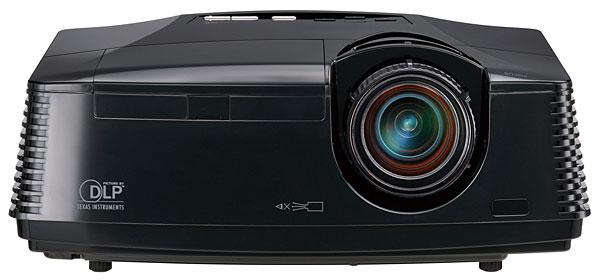Very nicely written review Scott.
Mitsubishi HC4000 DLP Projector

A front-projection system is usually the display of choice for serious home-theater enthusiasts. But such systems are more expensive than most flat panels and rear-projection TVs, especially when you consider the cost of a good screen. So finding a low-cost projector that performs well is the Holy Grail for those who want a true home cinema without breaking the bank.
In my quest to find such a projector, I spent some time with the Mitsubishi HC4000, and I was impressed. It isn't the last word in front projection, but it offers surprisingly good performance for under $1,500.
Features
Like most low-cost projectors, the HC4000 is based on DLP (Digital Light Processing) technology, using a single DMD (Digital Micromirror Device) chip with a rotating color wheel that filters white light from a lamp into red, green, and blue, one after the other in rapid succession. This can cause what's called the "rainbow effect," in which you sometimes see a momentary red/green/blue rainbow when looking at bright objects on a dark background. Some people are more susceptible to this effect than others, but it doesn't bother me much.
If you send this projector a movie at 24fps (frames per second) from a Blu-ray player, it will display it at 48Hz, showing each frame twice. This results in smoother motion than displaying such a signal at 60Hz. (Some people report that 48Hz looks somewhat stuttery, but I don't see it.)

The HC4000 has some pretty advanced features for such an inexpensive projector. For example, in addition to grayscale-calibration controls, it also provides a complete color-management system that allows individual adjustment of the red, green, and blue primary colors as well as the yellow, cyan, and magenta secondaries. Best of all, this CMS actually works; many CMS systems make the colors look worse, so this was a pleasant surprise. It also offers two anamorphic modes for use with an external anamorphic lens, which lets you fill a 2.35:1 screen with a 2.35:1 movie. Such a lens costs several times as much as this projector, so I'm sure very few users will engage these modes.
Other advanced features include separate Overscan and Shutter (masking) controls. When watching some digital TV channels, you can see "digital hash" at the upper edge of the picture, and the most common way to hide it is to zoom in a bit by engaging overscan, which crops that noise out of the visible image. However, this also reduces the effective resolution and causes other distortions, so being able to mask the edges of the image without engaging overscan is far better.
In addition, the HC4000 provides a sophisticated gamma adjustment, with separate controls for red, green, and blue in the low, middle, and high brightness ranges. I fiddled with these controls a bit, but they didn't seem to do much, so I left them at the default settings for the Cinema gamma mode.
 Ergonomics
Ergonomics
Like virtually all projectors I've reviewed, the HC4000's remote is simple and well organized, with dedicated input-selection and picture-control buttons. And it's fully backlit with red illumination, which is much better for dark-adapted eyes than blue. However, in my setup, with the screen 10 feet from my viewing position, it had barely enough power to bounce its IR signals off the screen and back to the projector.
The menu system opens with five tiny, labeled icons, and you must select one to see the corresponding controls. I'd prefer the menu to open with the previously selected controls already visible, or at least with the picture controls immediately visible—every button push counts in my book. The menus are well organized, but you must back out one level at a time; there's no way to completely exit the menu system with one button push. On the plus side, the menu system does not time out—it stays on the screen until you exit, which is great for setting the basic controls and calibrating the grayscale.
What's not so great for setting the picture controls is that the menu does not disappear when adjusting them. Fortunately, the menu is not all that large, and you can place it in the upper-left or lower-right corner of the screen, so it's partial obstruction of the image is less of a problem than with some other projectors. Also, if you access a basic picture control from the dedicated buttons on the remote, only that control appears at the bottom of the screen. In this case, however, the control disappears after only five seconds of inactivity.
- Log in or register to post comments


Aloha Scott from Hawaii!
I own the Mitsu HC5500 and I am happy with it, but, like all people in this hobby, I always look at everything out there....I was curious how you think these two products compare? Did you ever review the HC5500?
Thanks for all your information, you write good reports!
Paul





































































